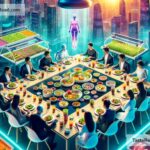The Future of Food and Inclusive Community Models: Building a Better Tomorrow
Food is something that connects all of us. It fills our stomachs, gives us energy, and brings families and friends together. But as the world changes, so does the way we grow, share, and eat food. New technologies, environmental concerns, and growing populations are pushing us to rethink how food works in our lives. In the future, food will likely not just be about nutrition—it will be about sustainability, fairness, and building stronger communities.
Let’s explore how the future of food and inclusive community models can create a healthier and happier planet for everyone.
The Changing World of Food
Right now, food is facing a lot of challenges. Many people in the world don’t have enough to eat, while others are throwing away large amounts of perfectly good food. Farming and food production also use up a lot of resources like water, land, and energy, which can hurt the environment. On top of that, climate change is making farming harder in some places because of floods, droughts, and extreme weather.
But humans are creative, and scientists, farmers, and communities are finding ways to address these problems. The future of food looks very different, with exciting innovations that promise to solve challenges in smarter, greener ways.
What Will Food Look Like in the Future?
Imagine walking into a supermarket 20 years from now. Instead of buying fruits shipped from across the world, you pick fresh apples grown in a “vertical farm” in your city. Instead of meat from animals, you buy plant-based or lab-grown alternatives that taste just like the real thing but are healthier for the planet. The future of food will depend on technology and smart ideas, and here are some trends to watch:
-
Vertical Farming
Vertical farms grow food indoors, stacking plants on shelves in buildings. They use less space, less water, and no pesticides. This could make fresh fruits and vegetables available in cities all year round. -
Plant-Based and Lab-Grown Meat
Traditional farming uses a lot of resources and often causes pollution, especially the raising of animals like cows and pigs. Plant-based products, like veggie burgers, and lab-grown meat offer a way to enjoy meat while lowering the environmental impact. -
Precision Agriculture
Technology like drones, sensors, and AI helps farmers use the right amount of water and fertilizer, protecting the earth while growing healthy crops. -
Upcycled Foods
Many companies are now turning food waste into tasty snacks or ingredients, like chips made from leftover vegetables or flour made from fruit peels. -
Food Personalization
In the future, food could be tailored to your specific health needs. For example, you might eat snacks made just for you, based on your body type, allergies, or personal preferences.
Creating Fair and Inclusive Food Communities
The future of food isn’t just about new technologies—it’s also about creating systems that include everyone. Right now, inequality in food is a big problem. Some people have access to healthy meals, while others struggle to afford basic groceries. This doesn’t have to be the case in the future.
Inclusive food systems make sure that everyone, no matter their race, gender, income level, or location, has access to fresh and healthy food. The idea is to build communities that are fair and supportive. Here’s how this can happen:
-
Local Food Networks
Many cities and towns are turning to local farmers’ markets and community gardens to grow food closer to home. This reduces costs, supports small farmers, and strengthens neighborhoods. -
Shared Food Resources
Community fridges and food banks are growing in popularity. These allow people—especially those facing financial difficulty—to share and access free food without judgment. -
Educational Programs
Teaching kids and adults about healthy eating, cooking, and gardening can encourage better choices. Community workshops on growing food or reducing waste can empower neighborhoods and create lasting change. -
Cultural Inclusion
Food is deeply tied to culture. Inclusivity means embracing food from different backgrounds, whether it’s selling diverse cultural ingredients at affordable prices or celebrating traditional recipes in schools and public spaces. -
Affordable Meal Programs
Governments, businesses, and organizations can step in with meal programs that are budget-friendly and open to all. Some restaurants are even creating “pay-what-you-can” models, where customers contribute what they’re able.
The Big Picture: Food as a Tool for Togetherness
At its heart, food is not just about survival. It’s also about community. A shared meal builds relationships and creates moments of joy. By focusing on inclusive food systems, we can use food as a tool to bring people together.
Imagine a future where everyone eats food that is fresh, affordable, and kind to the planet. Communities could gather in urban farms, cooking meals from locally grown produce and exchanging ideas and laughter. Food could be used to close gaps in society, making sure that no one is left behind.
What Can We Do Today?
The future of food begins now, and every one of us can play a part. Support local farmers, try plant-based meals, and waste less food at home. Volunteer at food banks or donate to organizations that tackle hunger. Advocate for policies that prioritize sustainable farming and fair access to food.
The future of food doesn’t belong to just one person or company—it belongs to all of us. By working together, we can ensure that everyone has a seat at the table and that our planet thrives for generations to come.
Let’s build a world where food isn’t just a necessity but a bridge to fairness, care, and connection.

